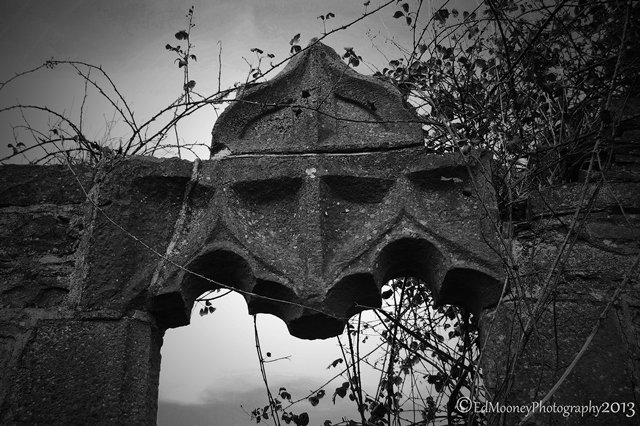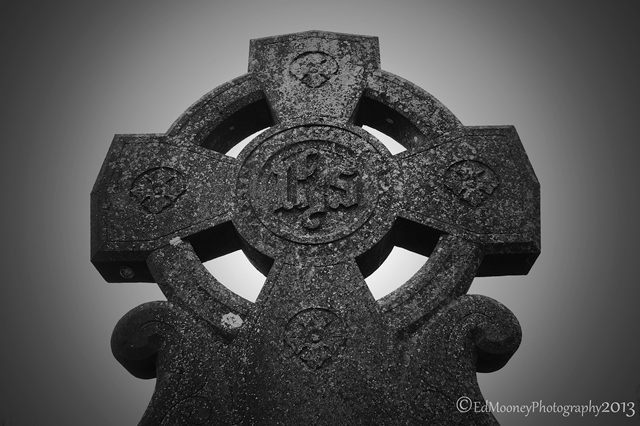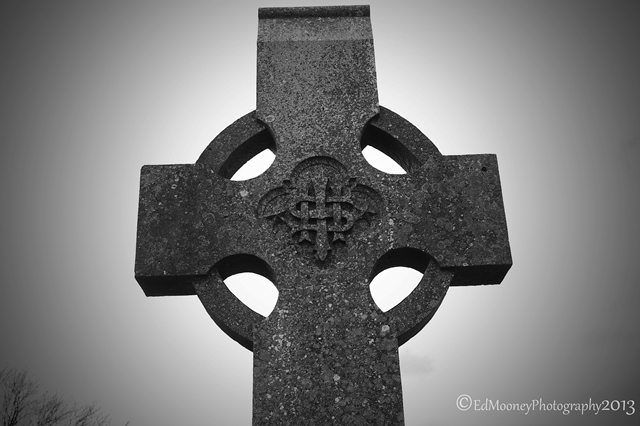Passing through Lucan recently I spotted an interesting stone structure in the distance. So as I do when the opportunity presents itself, off I went to explore with my trusty Nikon in hand. Perched on the summit of one of the nearby hills overlooking Esker Lane and the Griffeen Valley Park, just north of King John’s Bridge, lie the ruins of the medieval parish church of Esker. Esker is so called because this spot marks the beginning of the “Esker Riada” a line of sand and gravel hills is formed by the action of glacier movement which stretches from Lucan to an area of Galway known as Sli Mor. The ruin is said to date back to the 12th century. In days gone by, prior to being surrounded by the mass sprawl of urban housing developments it would have stood in a commanding position overlooking the former village of Esker.
Access to the Churchyard is up a set of steps in the corner of a housing estate in Esker Glebe. The iron gates are padlocked but there is a stone stile to the right of the gates for pedestrian access. The hill on which the ruin now stands has an uncanny appearance of an ancient burial mound similar to that used by our ancestors. Now I have been thus far unable to find any information to confirm this, so it will remain just my personal observation unless the nice people at the National Monuments Service decide to do some archaeological investigations.
Whilst I have little love for many of these Christian sites, I do appreciate them for their historical significance and the fact that they afford me the opportunity to take some nice images. Unfortunately the one thing that Pisses Me Off, (excuse my French) is the way in which they are treated by local communities. Like most ruins you can expect crumbling ivy clad walls and overgrowth etc. But when you come across such places that have been covered in graffiti, used as a dumping ground or a place for underage drinking I get really annoyed.
St. Finians Church is surrounded by some lovely ancient gravestones but has been neglected and fallen badly into disrepair over time. The grounds have become overgrown with various damaged grave stones hidden underneath. The gable end of the church overshadows the entire site St. Finian’s Church appears as far as I can make out to have been a long plain rectangular building, built from roughly coursed masonry. During the sixteenth century it is recorded as having undergone extensive rebuilding with the addition of a new timber roof. By the end of 1615 the church was said to have been in a ruinous state. Today, only the belfry end and some parts of the north and south walls remain. In the wall of the ruin there is reputed to be a cavity shaped like a chalice. There was a local tradition whereby people were cured of eye ailments by dipping their fingers in the water from the chalice and using it to wash their eyes. Another local story tells of a cavity in a nearby stone, known as the ‘Devil’s Foot’. The story goes that anyone who puts their hand or foot in the cavity will be unable to remove it. Within the ruins of the church are several graves, some with headstones dating back to the early 1700s.
In the 16th century there were 7 religious establishments located in the Esker area; St. Finians would seem to be the only one of these that has survived. In the early 1200s, King John handed ownership of the church to St. Patrick’s Church in Dublin, and when St. Patrick’s became a cathedral, the new Dean, William Fitzguido dedicated the church in Esker to St. Finian. Some records show that in 1830 there was a private school based beside the ruins of St. Finian’s Church. It was run by a Mr Sturgeon and provided a classical education for boys only.
Little information is known about some of the people buried there as the majority of graves stones have been eroded over the course of time. I have however found a story about a Fr. James MacCarten, who was murdered in Lucan. On the night of the 3rd of June 1807, Fr. MacCarten was returning home from Palmerstown when crossing the Hill of Lucan, today known as Chapel Hill, he was set upon by a gang of robbers who robbed and shot him dead. His murderers were both hanged, as was customary in those times, at the scene of the crime. He is buried within the walls of Esker Church ruin.
For more of my images, why not visit my Website,or follow me on Facebook, Instagram or Twitter.





















Great shots and so very interesting 🙂
LikeLike
🙂 thanks, yes if you dig deep enough some of these places really do have an interesting past.
LikeLike
Some fabulously atmospheric shots. I agree with you at how annoying it is when such beautiful places end up covered in graffiti and littered with beer cans. I recently sought out a tiny little ruined castle in Northumberland – Starlight Castle (it was built by star light in under a day following an 18th century wager!). On my way down from the castle I was met by two drunken locals with crates of beer – they were friendly enough but it seemed such a shame!
I love overgrown ruins – I love to see as nature reclaiming a site as this is all part of the history and evolution of a landscape (and its great for the wildlife too!).
LikeLike
Wonderfully spooky!
LikeLike
Beautiful photos Edward!! I love walking through graveyards and old churches, they always offer such great photo opportunities!
LikeLike
Great post, many thanks for sharing.
LikeLike
Thanks, 🙂
LikeLike
What a romantic-looking ruin, and the brambles and ivy only add to the effect. It is a real shame that the places are being used as rubbish dumping grounds though. Superb photos. I hope you didn’t try out the Devil’s Foot myth!
LikeLike
LOL, glad you enjoyed it, I am happy to report i still have full use of both hands, they come in handy for using the oul camera and typing. 🙂
LikeLike
Wow
LikeLike
An Edgar Allan Poe backdrop, dramatic yet soft and warm… great phots!
LikeLike
Thanks Patricia, glad you liked them, 🙂
LikeLike
Thanks Patricia, I’m glad you enjoyed them, 🙂
LikeLike
Good work! There is something about B/W photos that enhances architectural shots and really makes one notice all the small details that one often overlooks in colour photos. I especially like the Gothic feel of these shots.
LikeLike
Thanks Johanna, Im glad you enjoyed them, 🙂
LikeLike
Yeah thats my favorite too, got right down to ground level for that one, 🙂
LikeLike
These are gorgeous. I like the moodiness they exude.
LikeLike
Thank you, glad you liked them, 🙂
LikeLike
powerful and moody set of photos here
LikeLike
I love that gravestone under the tree with the odd lighting. It’s fantastic, in the true sense of the word. We hope to visit Mahee Castle (since we are the Maheekats!) and attempt to take such great pictures as yours.
LikeLike
Oh yes Thats Nendrum Castle up in Co. Down. As far as I remember is situated on an island on one of the Loughs. It was a towerhouse built back in the 1570’s, not much remains though. Cant wait to see your pics,
Keep in touch, 🙂
LikeLike